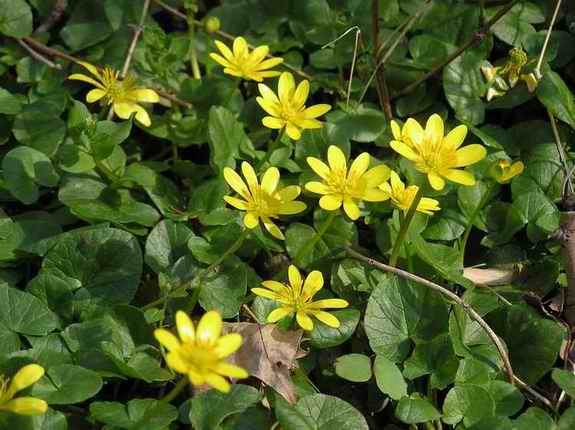|
Return to Hiker's Notebook Home Page
Common Name: Marsh Marigold, Cowslip, Mayflower, May blobs, Marybuds, Water blobs, Horse blobs, Bull's eyes, Meadow routs, Verrucaria, Solsequia, Sponsa solis, Kingcups - The primary common name is from the Middle English marigolde, a combination of Marie, thought to refer to the Virgin Mary, and gold for the color; Marsh is in reference to its preferred habitat.
Scientific Name: Caltha palustris - The generic name is from the Greek calathos which means a cup or goblet; the arrangement of the stamens and pistils resembles a small drinking cup. Palus is Latin for marsh, the species is therefore "of or from the marsh" to indicate its habitat in wet, boggy areas.
The variegated names of the Marsh Marigold attest to its familiarity in different localities according to its appearance. The onomastic process for common names is not governed by a recognized authority as is the case in the assignment of scientific names and is hence characterized by diversity. The common name marigold is a case in point, as the flower looks more like a buttercup and is in fact a member of the buttercup family (Ranunculaceae). One theory for the name marigold is that "mari" is from the Old English word for marsh, merisc. A more compelling theory is that it was used in the Middle Ages as part of church festival rituals, the gold flowers being presented to the Virgin Mary and becoming "Mary's gold" in the process. The alternative name Mayflower is a corollary to the theory, the flowers being used to celebrate May Day festivals.
The etymology of the many other names is lost to the passage of time and memory; one can only offer hypotheses as to their origins. The strident yellow of the flowers set in a thicket of glossy, reniform (kidney-shaped) leaves stands out against the background in a manner suggestive of blobs or splotches of color. May blobs, Water blobs, Horse blobs, and Bull's eyes are all likely references to the contrast. The yellow "flower petals" are actually petal-like sepals, stamens and pistils forming the cup-shaped structure in the center that has an almost coronal appearance, the probable basis for the name Kingcups. The names Solsequia and Sponsa solis refer to its opening of the flower at dawn with the rising of the sun and its closing at dusk. This diurnal fluorescence is captured in Shakespeare's Cymbeline, where musicians offer winking Marybuds to awaken Imogen in Act ii Scene 3:
Hark, hark! The lark at heaven's gate sings, And Phoebus 'gins arise, His steeds to water at those springs on chaliced flowers that lies; And winking Marybuds begin to ope their golden eyes: With every thing that pretty is, my lady, sweet, arise: Arise, arise.
The medicinal action of the Marsh Marigold is a matter of folk etiology, as no definitive testing has been undertaken to validate any palliative effects. As with most folk medicine, the health benefits are often conflated with superstitious prescription. English children reportedly share the widespread belief that staring at the flowers will make you crazy. On the other hand, the placing of large quantities of "Meadow routs" in the bedroom of children and adults who were subject to seizures reportedly brought relief, this attributed to the gaseous exhalations of the plant. A more popular remedy was a tea made from the roots of the plant that was used to induce sweating in the treatment of fever and as an emetic to induce vomiting. Various leaf and root tea concoctions were used by different Native American tribes according to their individual medicinal practices in the treatment of everything from the common cold to the rigors of parturition. It was also thought to be useful against the effects of a love charm, offsetting unwarranted advances. The Ojibwa tribe mixed the tea with maple sugar to make a cough syrup that was adopted by the colonists, who also believed that it was useful as an antidote for snake venom. There is no experimental evidence to support any of these remedies, though the plant contains anemonin, an acrid poisonous compound that may have some anti-tumor effects.
Marsh Marigolds are considered edible with caution and careful preparation; they are mildly toxic which contributes to their apparent utility as herbal medicine. After harvesting, the leaves must be soaked in two to three changes of boiling water to remove the poisonous constituents, the result a spinach-like green. The tightly closed buds can be pickled and used on salads much like capers, following the same decantation used for the leaves. However, the buds must be stored for at least a month before consumption; the pickling fluid should not be ingested. The consumption of raw leaves or buds without proper preparation will result in irritation and burning of the mucous membranes of the throat and nasal passages. The poisons, once ingested, can cause vomiting, bloody diarrhea, fainting and convulsions |
